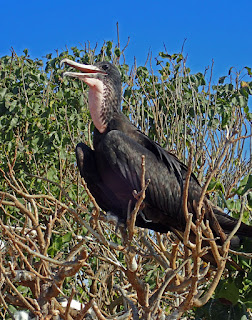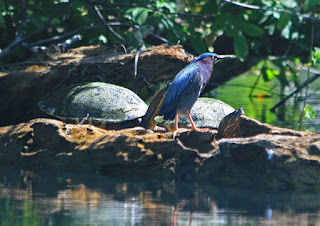An amazing week. It started with Jim's angry departure and morphed into one of the best weeks ever. Chacala is indeed the archtypical idyllic tropical cove, although it can be a rolly anchorage if you don't put down a stern anchor to keep the boat pointed into the swell. Isla Isabela is a remote, wild, and amazing place. Justly famous as the Galapagos of Mexico, with its blue-footed boobies, frigates and iguanas, all quite unafraid of humans. Not that there are many (humans, that is). I saw only the fishermen in the fishcamp, four other cruisers and an equal number of student researchers. Being about a hundred miles from the nearest port, it doesn't get a lot of tourists. After a couple of days at Isla Isabela, I headed for Mantanchen Bay, a large shallow bay with long gentle waves good for beginning surfers. There was so little swell that there was no surf at all while I was there. However, I walked a mile or two to the Rio Tovara, and went on the famous jungle cruise. Like the jungle ride at Disneyland, but it's all real, takes a couple of hours and only costs about $12. Had lunch and swam at Tovara Springs. Clear spring water, and they have a fence across the river to keep out the crocodiles. Really. From Mantanchen, I headed back to Chacala where I will spend a couple of days resting and cleaning up before I head back to Nuevo Vallarta via Punta de Mita.
 |
| Sunset in Punta de Mita |
 |
| Sunrise the next morning |
 |
| Anchored in Chacala |
 |
| Dinghy on the beach near the panga pier. |
 |
| The crescent beach and restaurants in Chacala Cove |
 |
| Circadian from the path to the beach |
 |
| View of the beach from the cockpit |
 |
| This is the rather humble town behind the beach. |
 |
| Dirt roads, a few shops and many hotels for local tourists |
 |
| Watching the sunset |
 |
I was in bed soon after this so I could be up at oh-dark-
thirty for the long run to Isla Isabela. Better to leave a familiar place in the dark, than enter a strange one. |
 |
Even so, when this is about all you can see,
night sailing is always a bit nerve-wracking,
even with full instruments.
|
 |
| There's nothing better than seeing the sunrise at sea! |
 |
I saw about a dozen sea turtles on the way to Isla Isabela,
including this beat-up old guy.
|
 |
About half of the turtles had a passenger. The birds
get a roost far out to sea; perhaps the turtles get
a look-out.
|
 |
| Approaching Isla Isabela after a 55-mile passage |
 |
The anchor set (hopefully) in the southeast cove.
Looking toward Punta Bobos.
|
 |
Anchoring at Isla Isabela can be chancy. The bottom is
rocky, so there is a chance the anchor won't set properly
or it will get jammed in a crevasse and can't be pulled up.
|
 |
What I hadn't reckoned on was a boat anchoring too close.
It was a small, light Catalina at least. Got within 8 feet,
but we never collided....as far as I know. Other than
that, I had no problems. |
 |
| This Heerman's gull was my first visitor from Isla Isabela. |
 |
There must be some secret appeal to this corner of my
solar panel. This little guy chose the same spot when
I arrived at Bahia Mantanchen a couple of days later.
|
 |
I was off early in the dinghy the next morning to explore
the island and take photographs.
|
 |
I landed the dinghy on the beach at the fish camp in
Bahia Tiberones.
|
 |
| The fish camp |
 |
The fishermen get a lot of unwanted attention from the
local populace when cleaning their catch.
|
 |
| Mending the net |
 |
| West of the fish camp are the trees where the frigates nest. |
 |
| Looking toward the anchorage from west of the fish camp. |
 |
Frigates: one in the bush, one in flight. You can see both
of the identifying characteristics of the frigate:
a split tail and extremely large wing span. |
 |
| Playa Iguanas, Bahia Tiberones |
 |
| Playa Iguanas |
 |
You can walk right up to the frigates
roosting in the scrubby trees.
|
 |
The males have an inflatable red sack under
the neck, although this guy's is a bit faded.
|
 |
| Frigate chick in the nest. |
 |
| Mom and chick in the nest. |
 |
While the frigates in this area are in the trees,
the iguanas are on the ground. |
 |
They are brown rather than green like the tree iguanas in
the Nuevo Vallarta jungle. Much better camouflage
when you are on the ground.
|
 |
The iguanas are unfazed by approaching humans, so much
so that you have to be careful to avoid accidentally
stepping on one.
|
 |
Even the many alligator type lizards seemed less
skittish than normal.
|
 |
To see the blue-footed boobies, I had to climb the caldera
(Isabel is a volcanic island), descend to the lake in the
center, go around it and up the other side to the east side
of the island.
|
 |
The island provides signs that it remains
a wild place, signs like these dry bones.
|
 |
| The path along the lake |
 |
| Frigate taking advantage of the updraft by the lake. |
 |
| A blue-footed boobie enjoying the ocean view. |
 |
| Yes, their feet really are blue! |
 |
| Boobies nest on the ground. |
 |
You can get pretty close, but if you get closer than about
5 feet they start to squawk loudly and...
|
 |
| ...give you the stinkeye. I'm told they will bite if you persist. |
 |
These eggs are probably old and/or bad.
The researcher I met on the island
told me the fresh ones are blue.
|
 |
| Mom and chicks |
 |
These big rock formations on the east side of the island
are called Las Monas.
|
 |
| Playa Las Monas, with many nesting boobies. |
 |
| Sooty terns nesting on the ground. |
 |
| Sooty tern |
 |
| Sundown at Isla Isabela |
 |
| Fishing at dawn off Isla Isabela |
 |
Then you can run across these guys, marking one end of
of big fishing nets. Not good to tangle with. The black
flags really help at night.
|
 |
After I anchored in Bahia Mantanchen, one
of the local fisherman decided to set his net
very close to me. Fortunately it was gone
by the time I left.
|
 |
The white-collared seedeaters like boat lifelines as
much in Bahia Mantanchen as in Barra de Navidad.
|
 |
I decided to take the kayak ashore rather than
the dinghy in case I had a long haul across
sand due to tidal changes. That meant
everything went into a large dry bag.
|
 |
| On the beach, tied to a tree. |
 |
| The famous very gently sloped beach. |
 |
The big highway intersection about a mile from the beach
was the only place I could get even a weak cell signal.
The large complex on the corner is a brewery. What else?
|
 |
| This was the gateway to the little roadside commercial area. |
 |
The local specialty was fresh-baked banana bread and
empanadas of various kinds. VERY GOOD!
|
 |
| The little church |
 |
The goal of my walk was to find the Tovara jungle
tour up the Rio Tovara. Circadian was anchored
right where the anchor symbol is. I found the
tour place with no problem. It's quite an attraction.
|
 |
| The Tovara tours are a large, professionally run business. |
 |
The tour starts with a slow passage through mangrove
tunnels.
|
 |
| Things gradually open up, but it's still a swamp. |
 |
| These huts were built for use in a movie. |
 |
When the foliage opened up a bit, the guide speeded up
quite a bit. It was like a jungle slalom.
|
The Tovara River Jungle Tour
 |
The turtles were more skittish than the heron,
so after they jumped into the water, I was able
the get another shot a bit closer. |
 |
| Tortugas. Shells about 15 inches long. |
 |
The turtles were very shy, and quickly jumped in the
water and swam away. They can make themselves
surprisingly hydrodynamic and swim quite quickly.
|
 |
We stopped at the crocodile preserve, which wasn't as good
as the one in La Manzanilla. It was more like a small zoo
that raised crocodiles.
|
 |
This is the restaurant at La Tovara Springs. Had a
mediocre lunch, but the view was great.
|
 |
I went for a swim in the fresh spring water. Fortunately,
there is a fence in the water to (hopefully) keep out the
crocodiles.
|






























